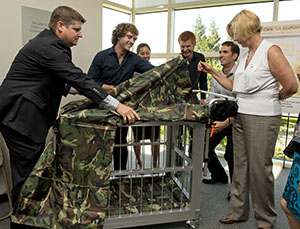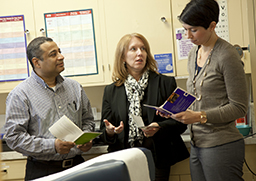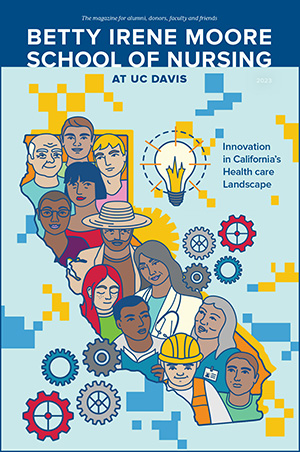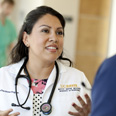Course distinctions: Community Connections
Innovative classroom and fieldwork course challenges UC Davis School of Nursing students to improve community health

Master's-degree leadership students Michael Dion (left) and Lori Jacoda (right) showcase their innovative dog kennel designed to enable pet-owning veterans to receive health-care services at the Sacramento VA Medical Center while maintaining contact with their pet. Click here to read the full story.
From the start of their graduate education, Betty Irene Moore School of Nursing at UC Davis students solve health-care challenges while immersed in local and regional organizations. Purposefully developed to differ from other nursing fieldwork courses, the year-long Community Connections course partners students with a community mentor to research and implement a system-wide solution.
“This course requires students to take risks, to break out of comfort zones,” said Deborah Ward, associate dean for academics for the Betty Irene Moore School of Nursing. “Students are embedded within an agency and they get their hands messy — so to speak — to create a pathway to change. For some students, the topic is not within their expertise, and that’s OK because we want them to forge partnerships with those who are the experts and learn how to facilitate change.”
Faculty match Nursing Science and Health-Care Master of Science — Leadership students with community organizations, whose size and missions vary — such as the Sacramento Food Bank and Family Services, the Veterans Affairs Northern California Health Care System, Yolo Hospice or Placer County Health and Human Services. Students work in groups with a mentor to design and complete a project which addresses a health-care issue.
Although projects span the course of an academic year, some groups continue to collaborate with the School of Nursing beyond the initial project, such as Sacramento City Unified School District. During the first year of partnership, the graduate students worked with the school district to complete a needs assessment and feasibility study to reopen a school-based health center at a high school. District leaders felt the community and high-school students’ perspectives were essential, since there is high rate of sexually transmitted diseases and teenage pregnancy reported at the high school.
Partners
School leaders attribute the success of the innovative Community Connections course to the partnerships between the students and community mentors. Click here to see examples of some of the current and previous participating agencies and organizations.
“Our job at the school district is to take care of students, but it means we never get to the bigger-picture thinking of where the school district needs to go and how we get there,” said Barbara Kronick, director of integrated support services at Sacramento City Unified School District. “However, the UC Davis master’s-degree students are research focused. They look at the big picture rather than concentrating on one-on-one services.”
Using data gathered by School of Nursing students, the school district secured federal funds to reopen the health center. Sacramento City Unified School District mentors worked with a new team of master’s students during a second year to create a plan to market the new health center to high-school students to promote maximum use of the facility.

Pam Whipple, Sacramneto City Unified community connections mentor (center), and master's-degree leadership stidents Alejandro Lara (left) and Joanna Mello (right) at the Hiram W. Johnson High School health center.
The graduate nursing students serve as consultants and utilize the expertise within the organization and community to find solutions. According to Jann Murray-Garcia, assistant adjunct professor at the School of Nursing who is a co-instructor and a co-designer of Community Connections, the course teaches students to rely on staff and seek out clients who may understand the strengths and deficiencies of a specific community program better than the highly educated policy leaders who design or operate it.
“The type of research these students lead does not take place in a lab far away from the people who may benefit,” said Murray-Garcia. “We want the nurse scholars to see that community expertise, to believe in it as necessary and valuable, and to incorporate it into what will then likely be the most effective, relevant and sustainable improvements.”
To enhance the fieldwork experience, students participate in weekly seminars that examine issues including organizational development and the varied means of financing health-care systems. Murray-Garcia said this is how students connect theory to practice.
Alumna Maureen Murphy, whose project focused on childhood obesity in Placer County, recalled her experience as the first time she used research to intensively problem solve a larger health-care issue.
“The course allows nurses to understand their strength in the health-care system and how they can contribute to changes in health-care delivery,” Murphy said. “The combination of classroom work and fieldwork created an incredible learning environment where students, mentors and instructors learned together.”
Community Connections culminates each spring with a research poster presentation for students to showcase their process and findings while improving their presentation skills. Mentors from each organization, students and other health-care professionals are invited to attend.





